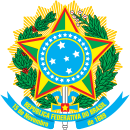
Back النشيد الوطني البرازيلي Arabic نشيد البرازيل الوطنى ARZ Himnu nacional del Brasil AST Braziliya himni Azerbaijani Бразилия гимны Bashkir Гімн Бразіліі Byelorussian Химн на Бразилия Bulgarian ব্রাজিলের জাতীয় সঙ্গীত Bengali/Bangla Himne Nacional Brasiler Catalan Brazilská hymna Czech
| English: Brazilian National Anthem | |
|---|---|
 Sheet music | |
National anthem of Brazil | |
| Lyrics | Osório Duque-Estrada, 1909 |
| Music | Francisco Manuel da Silva, 1831 |
| Adopted | 13 April 1831 (by the Empire of Brazil) 20 January 1890 (by the United States of Brazil) 6 September 1922 (lyrics adopted) |
| Audio sample | |
Official orchestral and vocal recording in F major by the Coral BDMG and Minas Gerais Military Police Symphony Orchestra | |
| Part of a series on the |
| Culture of Brazil |
|---|
 |
| Society |
| Topics |
| Symbols |
The "Brazilian National Anthem" (Hino Nacional Brasileiro) was composed by Francisco Manuel da Silva in 1831 and had been given at least two sets of unofficial lyrics before a 1922 decree by president Epitácio Pessoa gave the anthem its definitive, official lyrics, by Joaquim Osório Duque-Estrada, after several changes were made to his proposal, written in 1909.
The lyrics have been described as Parnassian in style and Romantic in content.[1]
- ^ "Você entende o Hino Nacional Brasileiro?". Só Português (in Portuguese). 1 August 2022. Archived from the original on 21 February 2022. Retrieved 1 August 2022.
You understand the Brazilian National Anthem? The National Anthem, symbol of exaltation of country, is a very complex song. Besides having unusual words, its lyrics are rich in metaphors. The text follows the Parnassian style, which explains the presence of flowery language and syntactic inversions, which hinder the understanding of the message. Thus, the prioritization of the beauty of form in the composition of the hymn compromised clarity. You, who already know how to sing the national anthem, do you know it because of its melody and tune, or do you know it for the meaning of its message? Most people, despite their mastery of the lyrics, are ignorant of their meaning. The following is the national anthem. Note the words highlighted and their definitions in parentheses. You'll likely be surprised by the things that you have always proclaimed, without, in fact, being aware of it.
